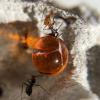hmm Lasius pallitarsis?

IDK if the mandibles work?
The large-eyed Lasius pallitarsis can be confused with any of the other three species in the niger group: Lasius neoniger, Lasius americanus or Lasius niger. The key distinguishing feature is that L. pallitarsis has a clearly defined offset, short, and upturned basal tooth on its mandible. This offset tooth is best seen in full-face view with the mandibles open, but if you can’t open the mandibles, count the teeth you can see. If you only see six (and the offset, seventh one is hidden under the clypeus), it is likely you have L. pallitarsis. (Ellison et al., 2012)
Starting this July I'm posting videos of my ants every week on youTube.
I like to make relaxing videos that capture the joy of watching ants.
If that sounds like your kind of thing... follow me >here<.


















